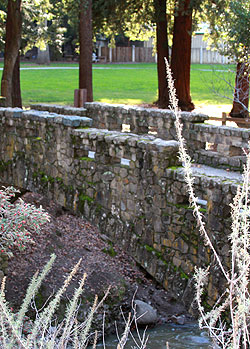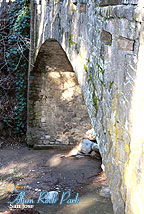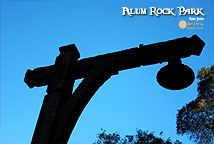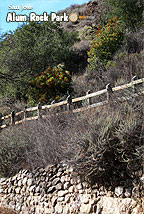
LOCATED IN THE WESTERN FOOTHILLS of the Diablo Range about eight miles
northeast of Downtown San Jose, this is the crumbled remains of a once-grand
resort that capitalized on the mineralized waters and hot springs that
flowed from the sedimentary rocks along the bottom of Penitencia Creek
in Alum Rock Canyon. Some of the springs included: sulfur, magnesia, iron
and carbonated soda springs. The 720 acre park was established by the
City of San Jose in 1872, the first municipal park in the state of California.
The native American people of the Ohlone tribelet, the Taunens, had lived
in the area of the Alum Rock Canyon for several thousand years before
the arrival of the first white explorers.
The Ohlones were a loose-knit group of people who lived in about twenty-five
“triblets” throughout the area. They were hunter-gatherers
which meant they lived off the bounties of nature without ever establishing
farmed crops. The Alum Rock canyon was home to valley oaks, which produced
the Ohlones’ favorite large, sweet acorns.
Life was so good that, like all California Indians, the Taunens were stone-age
people, they used no metal and did not create pottery or weave cloth.
They lived in an elegant harmony with nature - until the first Europeans
barged into their paradise about 250 years ago.
Spanish expeditions brought an end to the Eden which the Alum Rock Canyon had been. By 1797 there were six missions in Ohlone territory including Mission Santa Clara.
The canyon was also referred to as “The City Reservation” and “Penitencia Reservation” before the Alum Rock name was minted by a local farmer.
Though there is no “alum rock” in Alum Rock, there is a richness of rocks and minerals in its dramatic formations, but no gold and silver found by mining explorations in the 1860’s and again in 1913.
The presence of precious ores was not necessary to convince the San Jose Common Council to recognize the park as a geological treasure.
The 720 acre park was established by the City of San Jose in 1872, the
first municipal park in the state of California.
Right around the time the park was established and deeded to the City
of San Jose, a saloon and hotel were already in operation in the canyon
to take advantage of the beautiful area, as well as the 27 hot and other
mineral springs. There were some issues with the building’s lease,
and it mysteriously burned around 1890.
In 1891, the Parks Commission began development of a formal park, building
a new hotel called the Alum Rock House, private mineral baths, a dance
pavilion and picnic tables were all added.
The park’s most mystical and alluring attraction, the Alum Rock Meteor, was a wonderful asset to the publicists of the early days. How could anyone resist a visit to the large, mysterious alien rock (the largest on earth, it was said), which had plunged to earth near the Penitencia Creek entrance to the park? Trying to capitalize on its enormous investment in the park, the Peninsular Railway hyped the big rock and erected a sign indicating that it was the “Alum Rock Meteor” and that it weighed an estimated 2,000 tons. The rock would still be in the park today if its composition hadn’t been identified as manganese in 1918 during the early part of World War I. Manganese is an earthly metallic element which, when alloyed with steel, enhances its strength. It was in great demand for the war effort. The rock’s otherworldly persona was hastily discarded when the San Jose City Council realized that the city coffers could be enriched by $22,000 when a “mining man” offered such a sum for it. The purchaser soon discovered that the 2,000-ton rock actually weighed only 389 tons. Only thirty-nine tons of high-grade manganese ore was extracted and the buyer went broke. The City apparently was not able to collect on the debt and lost a big attraction to boot!
he massive rock probably had been in the park for millions of years, possibly part of a much larger rock mass which had eroded away.
Alum Rock Park has had few improvements other than the Alum Rock Saloon and the Alum Rock House hotel in the early 1870’s. The hotel burned down in 1890; the saloon was dispossessed after outlawing liquor sales.
The park’s fame was bolstered by recreational visits of soldiers during both WWI and WWII. They spread the word of the beautiful park and its many recreational features far beyond the Bay Area. Records show that on Easter Sunday, 1935, there were more than 4400 cars in the park.
One by one, the dowdy old attractions were dismantled leaving only the
mineral water pagoda (pre 1900), the log cabin (1916) and what would become
the Youth Science Institute building (1930's) to represent the eras of
the past.
Post cards: Alum Rock Park
Please click on the image to download FREE standard size (4X6 inch) high resolution (300 dpi), ready to print
"Alum Rock Park" post card.
Print it on your desktop printer, or take file to your local printshop.
If you need to print 100 copies or more, please check great prices at: Project Era Online Printing
If you need photo images for your design project, check our Photo Gallery
If you need any Graphic Design Services, we are always happy to help!
 |
 |
 |
| Postcard 1 | Postcard 2 | Postcard 3 |



